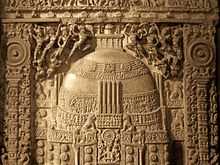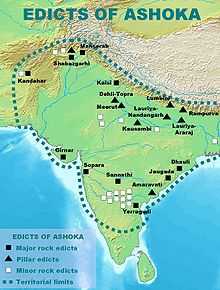Amaravati, Andhra Pradesh
| Amaravati అమరావతి Amareswaram Andhra Nagari | |
|---|---|
 Amaravati Location in Andhra Pradesh, India | |
| Coordinates: 16°34′22″N 80°21′27″E / 16.57278°N 80.35750°ECoordinates: 16°34′22″N 80°21′27″E / 16.57278°N 80.35750°E | |
| Country | India |
| State | Andhra Pradesh |
| District | Guntur |
| Area | |
| • Total | 214 km2 (83 sq mi) |
| Elevation[1] | 36 m (118 ft) |
| Population (2011)[2] | |
| • Total | 67,481 |
| • Density | 320/km2 (820/sq mi) |
| Languages | |
| • Official | Telugu |
| Time zone | IST (UTC+5:30) |
| Telephone code | +91–254 |
| Vehicle registration | AP–7 |
Amaravati is a village in Guntur district of the Indian state of Andhra Pradesh. It is located in Amaravati mandal of Guntur revenue division.[3][4] It is located on the banks of Krishna River, north of Guntur City.[5][6] Amaravati has been chosen as one of the heritage cities for HRIDAY - Heritage City Development and Augmentation Yojana scheme of Government of India.[7]
Etymology
Amaravati translates to The town lives forever in the local language.[8] It is also referred as Amareswaram, for its famous Amareswara temple dedicated to Lord Siva, one of the famous Pancharamas.[9] It was formerly known as Andhra Nagari.[10]
History
The recorded history of Amaravati and nearby Dharanikota dates to 2nd century BCE.[11] It was the capital of Satavahanas who ruled from 2nd century BCE to 3rd century CE. After the decline of Satavahanas, Andhra Ikshvakus and later Pallava kings ruled Krishna river valley. Subsequently, Eastern Chalukyas and Telugu Cholas held sway over the region. Kota Kings were in control of Amaravati during the medieval times. Kota kings were subdued by Kakatiyas in 11th century CE and Amaravati became part of the unified Telugu empire. The Skanda Purana gives a picture of the place and the Siva temple located here.[12]


Amaravati was part of Delhi Sultanate, Musunuri Nayaks, Bahmani Sultanate, Vijayanagara Empire, Sultanate of Golconda and Mughal Empire successively before founding Nizam of Hyderabad in 1724. It was ceded to France in 1750 but was captured by England in 1759 and was ceded to England. Guntur returned to Nizam in 1768 but was ceded to England again in 1788. It was briefly occupied by Hyder Ali. It was part of Madras Presidency during colonial period.
The stupa
The region between Krishna and Godavari rivers was an important place for Buddhism from the 2nd century BCE with Amaravati being one of them. Buddhist stupa was built during the reign of Ashoka in 200 BCE, was carved with panels that tells the story of Buddha. The discovery, misuse and destruction of the sculptures, preservation, distribution to various museums (Chennai, Calcutta, London, Masulipatnam etc.) have been poignantly described by Shimada.[13] During the period of the decline of Buddhism, this stupa was also neglected and it was buried under rubble. There is a 14th-century inscription in Sri Lanka which mentions repairs made to the stupa and after that it was forgotten. The stupa is related to the Vajrayana teachings of Kalachakra, still practiced today in Tibetan Buddhism.[14] Dalai Lama of Tibet conducted a Kalachakra initiation at this location in 2006.

Ancient art
Art historians regard the Amaravati art as one of the three major styles or schools of ancient Indian art, the other two being the Gandhara style and the Mathura style. Some of the Buddhist sculptures of Amaravati betray a Greco-Roman influence that was the direct result of the close trade and diplomatic contacts between South India and the ancient Romans. Indeed, Amaravati has itself yielded a few Roman coins. The Government Museum at Egmore (Madras Museum) and British Museum, London host the "Amaravati Gallery".[16]
Chinese traveller and Buddhist monk Hiuen Tsang (Xuanzang) visited Amaravati in 640 CE, stayed for sometime and studied 'Abhidhammapitakam'. Xuanzang wrote a glorious account of the place, Viharas and monasteries that existed.[17]
Amaravati School
In Amaravati, situated in the eastern Deccan, a different type of art form evolved and flourished for nearly six centuries commencing from 200-100 BC. Patronized first by the Satavahanas and later by the Ikshvakus and also by other groups (feudatories, officials, and merchants), four periods of activity are easily discernible.[18]
The Amaravati school of art occupies a pre-eminent position in the history of Indian Art. With its beginning in 3rd century BC the Amaravati unfolds its chapters through the galaxy of sculptural wealth that once adorned the Mahachaitya the majestic monument of the Buddhists situated here with its history extending over a period of a millennium and a half.[19]
Geography
The city is located at 16°34′N 80°22′E / 16.567°N 80.367°E[20] on the south bank of Krishna river.
Demographics
As of 2011 Census of India, the town had a population of 13,400. The total population constitute, 6,432 males and 6,968 females —a sex ratio of 1083 females per 1000 males. 1,321 children are in the age group of 0–6 years, of which 647 are boys and 674 are girls —a ratio of 1042 per 1000. The average literacy rate stands at 71.34% with 8,617 literates, significantly higher than the state average of 67.41%.[2][21]
Tourist places
The Amareswara (Siva) temple walls have lot of inscriptions that give information about the kings who ruled over the area. The present holy shrine of Amaralingeswara (Lord Siva) temple is associated with the reign of Vasireddy Venkatadri Nayudu who ruled the region before the advent of the British rule (See Amararama). He was well known for his benevolence, munificence and construction of a large number of temples and education centers in the Krishna river delta.[22]

Transport
It is reachable by road or by boat / coracle on the Krishna River. It is connected by the Amaravati road from the heart of Guntur. It is 46 km south west of Vijayawada. Gannavaram, north of Vijayawada is the nearest airport.
Culture
The people speak Telugu. The common traditional clothing for women is a Saree and for men a Panche or a Lungi and Uttariyam. The town was given a hagiographic portrayal in the famous short story series Amaravati Kathalu by Satyam Sankaramanchi. The stories describe the contemporary culture of local people during the reign of Vasireddy Venkatadri Nayudu and also post-independent times.
The town is a center of pilgrimage to both Hindus and Buddhists. Amaravati is also famous for the temple dedicated to the god Siva. The main Hindu festivals celebrated are Mahasivaratri and the Navaratri. The 30th Kalachakra festival, a popular Buddhist ritual was held at Amaravati in the first week of January 2006.
See also
References
- ↑ "Elevation for Amaravati". Veloroutes. Retrieved 31 July 2014.
- ↑ 2.0 2.1 "Census 2011". The Registrar General & Census Commissioner, India. Retrieved 25 July 2014.
- ↑ "Mandal wise villages" (PDF). Revenue Department - AP Land. National Informatics Center. p. 1. Retrieved 20 November 2014.
- ↑ "Adminsistrative divisions of Guntur district" (PDF). guntur.nic.in. Retrieved 26 May 2014.
- ↑ The Hindu : Magazine / Events : On a mission for enlightenment
- ↑ Express News Service. "Amaravathi to be The Name of AP Capital". http://www.newindianexpress.com/''. The new Indian Express. Retrieved 28 March 2015.
- ↑ "Introduction". HRIDAY official website.
- ↑ "Andhra Pradesh’s capital city Amaravati". Deccan Chronicle (Hyderabad). 6 April 2015. Retrieved 18 April 2015.
- ↑ "Other name of Amaravati". Guntur district website. Retrieved 31 July 2014.
- ↑ "Amaravati Museum". AP Tourism Department. Retrieved 31 July 2014.
- ↑ The History of Andhras, Durga Prasad
- ↑ Skanda Purana In: Puranic Encyclopedia, 1975, Vettam Mani, Motilal Banarsidas, New Delhi
- ↑ Early Buddhist Architecture in Context: The Great Stūpa at Amarāvatī (ca. 300 BCE-300 CE) by Akira Shimada, Brill, 2012, 322 pages; ISBN 9004233261, 9789004233263
- ↑ Kilty,G Ornament of Stainless Light, Wisdom 2004, ISBN 0-86171-452-0
- ↑ Reference: "India: The Ancient Past" p.113, Burjor Avari, Routledge, ISBN 0-415-35615-6
- ↑ Sculptures from Amaravati in the British Museum, D. Barrett, 1954, Trustees of the British Museum, London
- ↑ Travels of Xuanzang: http://www.odiseos.net/XTWeb/index.html
- ↑ http://www.preservearticles.com/2011101815589/what-were-the-salient-features-of-amaravati-school.html
- ↑ http://asi.nic.in/asi_museums_amravati.asp
- ↑ Maps, Weather, and Airports for Amaravati, India
- ↑ "Literacy of AP (Census 2011)" (PDF). Official Portal of Andhra Pradesh Government. p. 43. Retrieved 5 September 2014.
- ↑ Sri Raja Vasireddy Venkatadri Nayudu, 1973, K. Lakshminarayana, Ponnuru (http://www.openlibrary.org/details/rajavasireddyven022548mbp)
| ||||||||||||||||||||||||||||||||||